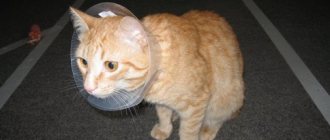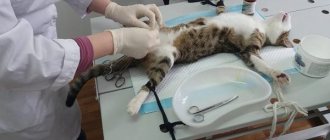What will you learn from the article?
- When to castrate a cat?
- Is it worth doing?
- How to prepare a cat for surgery?
- How does the operation take place?
- How to care for a cat after castration After local anesthesia
- After general anesthesia
- When to contact a veterinarian immediately
- Prices
By 6-8 months, cats reach sexual maturity, and the owners need to make an important decision - to castrate the cat or start looking for a bride for him. From the article you will learn what castration is, when it is performed, how to prepare a cat for it, what you need to know about this operation and the features of caring for pets after.
Castration of a cat is a surgical operation to remove the gonads from an animal.
After removing hair from the scrotum area, the doctor makes incisions, cuts off the spermatic cords, and removes the testes. The operation takes place under general anesthesia or local anesthesia.
When to castrate a cat?
At 6-12 months
According to veterinarians, the optimal age when cats can be castrated is from 6 to 12 months. At this age, the condition of the genital organs is ideal for surgery, and the influence of sex hormones on the animal is minimal. It is best to carry out the operation before the cat has time to “walk”.
What happens if you choose a different age?
If you castrate a cat too early, the animal's development may slow down. The level of sex hormones affects the rate of muscle growth. Early castrates can be smaller than their relatives and look like 10-month-old kittens until old age.
Castration too late (after 2-3 years) leads to the fact that the animal has already been formed under the influence of sex hormones and has certain habits. Therefore, after the operation the cat can continue to behave the same as before. The second disadvantage is that cats that were operated on late have a higher risk of developing obesity. Third, adult cats have a lower pain threshold, so the operation must be performed under anesthesia.
Lack of interest in the opposite sex
Many owners of neutered cats rightfully believe (and quite logically) that after the operation their pet should no longer be eager to see cats and run away from home for this. But in practice, everything happens a little differently... The fact is that, as we have already said, sex hormones are responsible for sexual desire.
But even removing the testes cannot dramatically remove them from the bloodstream. Hormones can remain in the blood for some time, and then be released from the subcutaneous fatty tissue. The more well-fed the cat, the longer this period can last, the slower its character will change.
Sometimes there are situations when an animal that was castrated more than two months ago still runs after cats. Of course, this cannot be called a typical case, but it still happens from time to time.
There is no need to worry too much: over time, the amount of hormones will decrease anyway; owners just need to be patient.
But what if you urgently need to change your cat’s behavior? In such cases, the use of special sedatives can be recommended. Quite cheap and quite effective, for example, “Cat-bayun”. But you should still consult your veterinarian before doing this. Perhaps he will recommend more effective means.
Is it worth doing?
Pros:
- Change in behavior, lack of aggression;
- The cat stops marking his territory. Even if the instinct persists for some time after the operation (this is possible with late castration), the smell of urine becomes less pungent;
- The animal will not strive to leave its home - the risk that the cat will run away for a walk is reduced;
- The risk of developing malignant genital diseases is reduced several times.
Consequences (cons):
- The risk of the operation itself, performed under general anesthesia. To reduce it, do not neglect preparatory measures, carefully choose a clinic and veterinarian. Do not forget about a preliminary consultation with a veterinarian, choose modern anesthesia and procedure techniques.
- Risk of postoperative wound infection. Follow all doctor's recommendations, treat the wound, and prevent scratching and licking. If infected, contact your doctor immediately for treatment.
- Risk of pet obesity. After surgery, provide your cat with more active physical activity. Pay enough attention to your diet - reduce the serving size. After consulting with a veterinarian, switch the cat to specialized food for castrates.
Why do they do this?
When a cat reaches 9-10 months of age, his instincts begin to manifest themselves with might and main. One of them is the fight for territory. The pet constantly defecates to show that it is the boss in the apartment and this creates an unbearable environment.
Should a cat be neutered?
In an effort to gain the attention of cats, the male cat constantly makes loud cries, preventing anyone from sleeping. In this case, the owner decides whether the cat needs to be castrated, but the inconvenience factor often tips the scales in favor of the procedure.
In order to make a normal life possible with a cat in an apartment, he is castrated.
Important! If the operation is performed earlier than the recommended age, this may lead to disturbances in the development of the animal’s genitourinary system.
How to prepare a cat for surgery?
The operation is dangerous for an animal with a weakened immune system, in the presence of diseases and during the recovery period. Therefore, the decision about castration surgery should be made after examination and consultation with a veterinarian. And the animal must be properly prepared for it.
Preparation for castration surgery:
- Preliminary inspection. It is carried out by a veterinarian to assess the general state of health and identify possible contraindications to the operation. As part of the examination, urine and stool samples are taken. In some cases: late castration, breed characteristics (British and Scottish cats), examination by a cardiologist, ultrasound of the heart and cardiogram will be required.
- Vaccination. The cat must have all necessary vaccinations and undergo a quarantine period (3-4 weeks).
- Anti-flea and anthelmintic treatment. 3 weeks before the proposed operation, the cat must be removed from fleas and worms.
- Anti-stress measures. In case of increased nervousness and excitability of the animal, the veterinarian prescribes sedatives 2-3 days before surgery.
- Laxatives. As prescribed by the doctor, a laxative is given 12-24 hours before surgery. So that immediately after the operation the animal does not have the urge to go to the toilet. This can negatively affect the healing of the wound and cause pain in your pet.
- Fasting and drinking regime. The animal is stopped feeding 12-16 hours before surgery. Access to water is stopped 3-4 hours before the procedure. If the cat's stomach is full, the anesthesia can cause a gag reflex - this is dangerous.
Video about preparing for surgery:
https://www.youtube.com/watch?v=88l0Q9o3nfg
Diseases
Unneutered cats are susceptible to the following diseases:
- Prostatitis is an inflammation of the prostate gland that occurs due to the penetration of pathogenic microorganisms into the prostate tissue.
- Diseases of the urinary system. Among them: urolithiasis;
- urocystitis (inflammation of the bladder);
- nephrosis;
- nephritis;
- pyelonephritis.
Castration will greatly reduce the risk of these diseases.
Thus, surgery is the safest and most humane way to solve all problems associated with cat behavior.
How does the operation take place?
The first thing a doctor does in a clinic or at home is administer anesthesia. The veterinarian selects the type of anesthesia depending on the pet’s condition after examination and its age.
- Intravenous anesthesia. The most effective and safe anesthesia. It goes away quickly and is easily tolerated.
- Intramuscular. The classic method is affordable.
- Inhalation. Expensive and complex, practically never used.
After the animal is put under anesthesia, the veterinarian removes the hair and disinfects the surgical area. A longitudinal incision is made in the scrotum area with a sterile scalpel.
The doctor removes the testis from the scrotum and ties the spermatic cord with a self-absorbing thread to prevent bleeding. After this, the testis (testicle) is excised. In a similar way, the doctor repeats the procedure for the second testis (testicle).
The wound is dried with a sterile cloth and treated with an antibiotic-based spray. In veterinary medicine, two surgical technologies are used: with self-absorbing sutures and sutureless. After the wound heals, a small scar of 1.5-2 cm remains.
Video:
Anesthesia
The operation is performed under general anesthesia. Veterinary clinics use the inhalation method, intramuscular and intravenous injections, and gas anesthesia for anesthesia.
The latter has no side effects, does not cause pain and does not have any side effects on the body. In addition, the supply of gas anesthesia is controlled during the period of manipulation: the concentration of the drug can simply be reduced or increased. With this type of anesthesia, your pet can be quickly brought out of this state.
The drugs used for anesthesia are determined by the doctor depending on the general health of the animal and other indicators. Under anesthesia, the cat sleeps, does not perceive pain, his consciousness is turned off and his muscles are relaxed. The selection of drugs is carried out individually in veterinary clinics. Intravenous anesthesia is considered the most effective.
The substance acts quickly and has no side effects on the heart and lungs. The intramuscular method has an affordable price and is considered traditional. Inhalation, in comparison with other methods, is more complex and expensive, and is rarely used.
How to care for a cat after castration
The nature of postoperative care depends on what kind of anesthesia was used: local anesthesia or general anesthesia.
General requirements:
- After surgery, your cat will have chills. Prepare in advance a secluded, warm place to rest. Change the bedding to clean and ironed cotton fabric;
- Do not place the cat in a high place. It should be located on the floor. After surgery and anesthesia, the animal will have poor coordination of movements and may fall;
- Move the tray closer to the resting place to make it easier for the cat to get to it;
- Remove litter from the tray. The granules can injure or clog the wound. Instead of filler, you can use disposable pet diapers;
- If the cat does not go to the toilet in the litter tray, and this can happen, do not scold the animal;
- If the cat tries to lick a wound, use an Elizabethan collar.
After local anesthesia
After local anesthesia, the cat is conscious and all that is required from its owner is to treat the postoperative suture (if necessary) with special antiseptic agents, as well as thoroughly clean the litter box after each trip to the toilet. The animal may be inactive and look for a secluded place - if this lasts a short period of time after the operation, then there is no need to worry.
After general anesthesia
After general anesthesia, the cat will sleep for some time, and when it wakes up it will be weakened and disoriented. While the animal is recovering from anesthesia, it walks poorly, staggers and can easily injure itself - do not leave it unattended!
Do not force your cat to drink or forcefully offer food. The first meal can be 8-12 hours after surgery - the food should be light and in small quantities.
If your pet has a dry mouth, you can drop a couple of drops of water into the mouth to moisten the tongue. Do not force-feed copious amounts of water. The animal will drink on its own when it fully recovers from anesthesia.
When to contact a veterinarian immediately
- After castration, the pet does not eat for more than 2-3 days;
- On the first day after surgery, an increase in body temperature is observed;
- The cat has difficulty breathing, paleness or severe redness of the oral mucosa;
- Swelling has appeared.
A cat's recovery after surgery is much faster than that of a cat after sterilization. This is due to the fact that cats have a less invasive operation, i.e. requires a minimal area of intervention with a low degree of tissue trauma.
Video - care after surgery
Optimal age for surgery
Usually cats are castrated at about 6 months of age, but many animals have already reached sexual maturity by this time. Therefore, castration can be carried out earlier - at the age of about 4 months. Often, breeders sell already neutered animals in order to avoid unwanted use of them in breeding work.
Hurry up, choose a box and find out what gift awaits you
Discount on pet insurance
Promo code copied to clipboard
Complications after surgery
The reaction to surgery is individual for each animal. After castration surgery for a kitten, the following complications are possible:
- Vomit. Typical reaction to anesthesia. If the cat vomits once and not profusely, make sure that the animal does not choke in the vomit. Turn the cat's head to the side. If vomiting is severe and uncontrollable, immediately inform the doctor who performed the operation.
- Hyperthermia. Fever, drowsiness and weakness are a normal reaction of the animal to surgery and anesthesia. This condition occurs in all cats in the first postoperative hours and can last up to 2 days. If the animal's body temperature is above 39°C and lasts more than 1-2 days after surgery, contact your veterinarian.
- Refusal to eat, lack of appetite. Fasting on the first day after surgery is normal.
- Reduced temperature. If the animal's body temperature drops below 37°C, cover it with warm heating pads. If this does not help, urgent medical attention is needed.
- Infection of a postoperative wound. Slight redness or swelling is allowed in the first 3-4 days after castration. If redness or discharge from the wound increases, you should seek help from a veterinarian.
- Inflammation of the stump of the spermatic cord. It can develop in cats in the first week after surgery. This is indicated by: lethargy, painful swelling at the operation site and an increase in the cat’s body temperature.
- Internal hemorrhage. You should be alert to: weakness and lethargy of the cat, drowsiness, pale oral mucosa (white). Each touch to the animal will cause a painful reaction in it. You cannot do without the help of a veterinarian.
- Obesity. Changes in the animal's hormonal levels after surgery cause metabolic disorders. He slows down. Possible weight gain. Do not overfeed your cat and create a balanced diet.
Important!
Stay close to your cat after surgery and contact your veterinarian if any suspicious symptoms occur.
Pros and cons of the operation
Is it necessary to neuter a cat? This issue raises doubts among animal owners. Some people are afraid of surgical and postoperative risks; others are against interference in natural processes; Still others believe that castrating a domestic cat is inhumane. However, sexually mature animals, deprived by humans of the opportunity to satisfy their instincts, suffer: they scream, show aggression, mark their territory, and try to escape from the apartment. And then the owner comes to the decision to go to the veterinary clinic.
The choice is not easy to make, but the advantages of castration are much greater than the disadvantages.
- The reproductive instinct disappears. Animals that have the opportunity to walk begin to spend more time at home. Apartment cats stop worrying and screaming, become more affectionate, and are better trained.
- The level of cleanliness increases. Uncastrated individuals mark the territory of “their” apartment for various reasons: in an effort to prove superiority, to attract a female, to take revenge on the owner, because of stress or boredom. As soon as the production of hormones stops, cats no longer need to leave their scent on walls, furniture and clothes.
- Aggression decreases. If several cats live in an apartment or the pet goes for walks outside, then castration is a great way to create a calm atmosphere. Animals do not need to share a female or territory, the likelihood of fighting and injury is minimized.
- The risk of disease is reduced. An infected cat can transmit herpesvirus infections, parvovirus enteritis (colloquially called feline distemper), calicivirosis, etc. to the cat. In addition, a neutered cat will not suffer from testicular cancer or diseases of the testes and prostate.
- Life expectancy increases. With proper nutrition and regular visits to the veterinarian, neutered cats live longer than their unoperated counterparts, by 3-5 years.
The disadvantages of castration are the inability to get offspring from a pet and the risk of rapid weight gain after the procedure. The first point is relevant for owners of rare breed cats: the operation is irreversible, so you should think carefully before visiting the veterinarian. The weight of a cat depends entirely on the behavior of the owner: a thoughtful diet and an active lifestyle allow a neutered cat to be in shape for many years.
What is the price
Russia
- Moscow and St. Petersburg – 1000 – 3000 rubles;
- Regions of Russia – 850 – 2500 rub.
Ukraine
- Kyiv – 350 – 900 hryvnia;
- Regions of Ukraine – 250 – 500 UAH;
Be careful when choosing a clinic. If a small and attractive price is indicated, it is quite possible that this is a marketing ploy with which they are trying to lure you.
A suspiciously low price for castration indicates that you may be additionally billed for anesthesia, medications and consumables. Take the time to find out everything in detail before you sign up for the operation.
In the apartment
An uncastrated cat living in an apartment causes a lot of inconvenience to its owner. If you are not going to castrate your pet, then be prepared to face problems such as:
- Tags. Most unneutered cats mark their territory in this way. This is the natural behavior of a sexually mature animal; it is useless to scold for it. Animals periodically mark the owner’s things, furniture and corners. The tags have a strong odor that is difficult to get rid of.
- Night screams. With a loud cry, the cat scares away rivals from the house and at the same time notifies the females of its presence.
- Aggression. With the onset of puberty, a previously affectionate, playful kitten can become an aggressive male. This is due to the action of testosterone, which encourages the cat to strive for leadership and conquer territory.
Is it worth castrating a cat at home?
If you do not want to take your pet to the clinic or are unable to do so, consider having neutering surgery at home.
Features of preparing and performing surgery at home
- The animal is prepared in the same way as for an operation that is performed in a hospital setting;
- You need to prepare a clean room. A bathroom that is washed using household disinfectants, dried and ventilated is best suited. It is impossible to achieve sterility at home, but it is not necessary. Castration is not an abdominal operation;
- A table for surgical procedures is installed in the prepared room. It is also disinfected.
Pros:
- Saving time on transporting the animal to the clinic;
- The animal does not experience stress from transportation;
- After the operation, the cat is in a familiar environment, he recovers faster;
- There is no risk of infection from other animals.
Minuses:
- Inability to achieve sterility;
- There is no equipment for resuscitation measures. It may be needed if the animal has an individual negative reaction to anesthesia or medications;
- Calling a specialist to your home is more expensive and may depend on the distance of the house from the clinic.
Prices
Russia
- Moscow and St. Petersburg – 2200 – 3000 rubles;
- Regions of Russia – 1500 – 2500 rubles.
Ukraine
- Kyiv – 500 – 900 hryvnia;
- Regions of Ukraine – 400 – 500 UAH;
Contraindications to castration
Anesthesia is always stressful for the body. The heart, kidneys and liver begin to work hard to remove toxins and get rid of the effects of anesthesia. The condition of these organs determines whether adult cats can be castrated.
Contraindications for testicular removal are:
- heart failure;
- vascular diseases;
- the presence of infection and inflammatory process;
- epilepsy;
- severe pathologies of internal organs;
- diabetes;
- underweight;
- urolithiasis disease;
- allergy to anesthetics.
If the animal has one or more of the above contraindications, you will have to look for an alternative to castration. Otherwise, the possible consequences may be fatal.
After examining the cat, performing diagnostic procedures and taking all the necessary tests, the veterinarian will tell you whether the operation can be performed. The animal owner’s task is to listen carefully to the doctor and do as he says. This is the key to a healthy and long life for your pet.
Alternative methods of castration
Modern veterinary medicine also knows other methods of castration (sterilization) of cats. They are used as an alternative to surgery, but not as often as the classic method.
- Vasectomy (sterilization). It involves ligating the vas deferens. The cat loses the ability to have offspring, but does not lose the ability to mate. The operation is complex and expensive.
- Radiation sterilization. Targeted irradiation of the cat's reproductive organs (testicles). The method is rare, expensive, and requires special high-tech equipment.
- Temporary chemical castration. An implant containing a substance that suppresses the animal’s sexual desire is inserted under the animal’s skin. Expensive way.
- Hormonal temporary sterilization. Once every six months, the animal is given a hormonal injection that suppresses sexual desire. This manipulation is carried out for life.
Important!
All methods can be used to castrate a kitten, but surgery is considered the most effective and safest today.
Whether or not to castrate your cat is up to you to decide. But remember that not only we humans should live comfortably, but also our pets for whom we are responsible.
Experience of mass castration and sterilization of stray animals
Volunteer practice in many cities shows that there should be no serious consequences after castration.
After all, it is mainly adult, sexually mature animals that are castrated, limiting the increase in the street population. Many veterinarians associated with volunteers primarily engage in castration and sterilization, as they say, on-line. All cats and cats operated by them successfully recover from anesthesia and either return to their usual environment or are sent to foster care with subsequent placement.
How does the intervention work?
Many owners worry that the cat experiences pain and discomfort during the procedure. In fact, the only unpleasant moment is the injection of an anesthetic drug. Regardless of how cats are castrated (under general or local anesthesia), they do not feel pain.
As soon as the anesthesia takes effect, the doctor proceeds directly to the manipulation. How this happens depends on the type of procedure chosen. Typically, the testes are removed through two small incisions in the scrotum, after ligating the spermatic cords. At the end of the procedure, the veterinarian will give detailed instructions on how to care for the cat after castration.
Preoperative period
In order for castration to take place without complications, the pet must be properly prepared. You need to start with a visit to the veterinarian. He will examine the animal, prescribe additional examinations if necessary (ultrasound of the heart, blood and urine tests), and tell you how to prepare the cat for removal of the testes. Typically, preparing a cat for castration involves following a special feeding and drinking regimen. In each specific case, the preoperative period may differ slightly.
Preparation for the procedure
What should you do before the operation? 12 hours before the scheduled visit to the clinic, you must stop giving the animal food. Feeding a cat before surgery is not recommended due to the fact that anesthesia causes a gag reflex, and the animal may choke on vomit. They stop giving him water 3 hours before the planned castration. In some cases, it is necessary to give a cat a laxative before castration. There is no need to wash or clip the animal.
Advantages and disadvantages
Castration has its pros and cons. The following arguments can be given in favor of the operation:
- the animal will be in a constant state of stress if the desire to mate is not satisfied;
- there is nothing good about taking birth control and hormonal pills throughout your pet’s life;
- there is a high risk of acquiring various diseases when a cat is sexually active;
- the animal will stop marking its territory after a few months;
- Fights between cats can injure, undermine health and even shorten the life of the animal. A neutered pet will not participate in fights, as it will be absolutely not interesting to him;
- such animals become very affectionate, flexible and easy to train;
Postoperative period
To quickly restore the cat and prevent complications, it is necessary to follow all the specialist’s recommendations in the two-week period after the intervention. Features of care on the first day depend on how long the anesthesia wears off after castration of the cat. Animals that require castration under general anesthesia require the most attention.
Post-operative care
Upon returning from the clinic, the cat should be placed on a bedding and covered, since as a result of the administration of painkillers, natural thermoregulation is disrupted. Every 20-30 minutes it must be turned over on one side or the other, which will make it possible to prevent numbness and muscle spasms. As cats recover from anesthesia, they may experience unsteadiness on their paws, a staggering gait, and blurred vision. After castration, a cat may behave somewhat strangely: hide, not make contact, or be restless and overly active. During the first few days after castration, this behavior is within normal limits.
If the cat starts to get up, you need to place a tray nearby so that he doesn’t have to go far. Sometimes 1-2 times after surgery, a disoriented animal may wander past the tray or diaper. In this case, you should not scold the cat, since these are just consequences of the operation.
If your cat licks stitches too often or suffers from oral diseases, a special collar may be required in the postoperative period. It will prevent infection and suture dehiscence. How long to wear a collar? The timing is determined by the veterinarian depending on how long the wound takes to heal. It is recommended to bathe the animal no earlier than 2 months after the procedure. If necessary, contaminated areas can be wiped with a damp, well-wrung out sponge.
Proper care in the first days is very important, since the successful outcome of the procedure largely depends on it.
How long does it take to recover from anesthesia?
To correctly assess your pet’s condition, you should know how long it takes for cats to recover from anesthesia. It all depends on the method of pain relief, the characteristics of the body, the drug and the correct calculation of the administered dose.
So, how long does it take for a cat to recover from anesthesia after castration? Sleep usually lasts from 30-40 minutes to 4-5 hours. If a castrated cat does not come to his senses for a long time, you should periodically check his reactions: touch his nose, paws, ears. The cat's attempts to pull his paw or move his ear indicate that there is no reason to worry.
Feeding
Caring for a cat after castration includes a certain drinking and feeding regimen. As soon as the animal wakes up, it needs to moisten its larynx. To do this, a small amount of liquid is poured into the cat’s mouth in small portions, since the swallowing reflex is not restored immediately. A bowl of water is placed when the cat has completely recovered from the effects of the drugs.
Feeding a cat is carried out only if the animal itself shows interest in food. You shouldn't do this by force. Portions should be small, and the volume of food the cat should be increased gradually.
What to feed
What to feed a cat after castration? In the first days, it is worth giving light food: meat or fish puree, dry food pre-soaked in water.
After how long
How long after castration can you feed a cat? Typically, 7-8 hours are enough to recover from anesthesia. You can give food to your cat no earlier than this period.
Complications
All possible complications of castration are divided into those that occur immediately after the procedure and later ones that appear during the healing process. In the first hours after the cat has undergone surgery, it is necessary to monitor its condition. If swelling, wheezing, or a sudden change in temperature or color of the mucous membranes occurs, you should immediately seek medical help. A cat’s poor reaction to anesthesia can result in death if not intervened in a timely manner.
The most common postoperative complications in cats include swelling and hematomas. In such cases, the animal does not go to the toilet for a long time, licks the enlarged scrotum, and shows anxiety. As a rule, blood or lymph that has accumulated in and around the scrotum dissolves on its own after some time.
Castration can cause more dangerous complications in cats: infection of the sutures (accompanied by fever and purulent discharge), damage to the urethra (the cat's urine will contain blood), bleeding and hemorrhages. In order for castration to take place without complications, it is necessary to properly care for your pet and trust it only to a proven, qualified specialist.
How long does it take for a wound to heal after castration? With standard castration, a period of 7 to 10 days is considered the norm.
Methods
In veterinary practice, various methods of castration of cats are used. Each of them has its own characteristics, advantages, optimal age and possible undesirable consequences. Before deciding to choose a castration method, you should consult with a veterinarian, who will determine which is best, taking into account the age and condition of the cat. Currently, the following types of procedures are used in veterinary medicine.
Chemical
Castration involves the regular administration of medications that suppress estrus. Chemical castration of cats is a reversible procedure: after some time after stopping the use of drugs, sexual function and the ability to reproduce are restored.
Surgical
The surgical method is used most often in veterinary practice. The technique is as follows: the scrotum is cut, the spermatic cords are tied up, the testes are cut off and taken out. Surgical castration is performed under anesthesia; the recovery period lasts until the cat’s wound heals.
Mechanical
Bloodless (or mechanical) sterilization of a cat involves squeezing the vas deferens with veterinary forceps. As a result, the ducts atrophy and dissolve over time. The bloodless method is irreversible. Its advantages include low cost and short rehabilitation.
Radial
The essence of the method is to expose the testes of cats to certain doses of radiation. After castration by irradiation, a cat's eggs stop producing hormones and viable sperm. Radiation sterilization has many disadvantages: after irradiation, the risk of developing inflammatory processes and the formation of malignant tumors increases significantly.
Hormonal
This is the name of medical castration using hormonal drugs. The introduction of hormones of the opposite sex temporarily suppresses sexual function. The procedure is considered reversible. Chemical and hormonal castration does not require preliminary preparation and long-term rehabilitation of the cat.
Vasectomy
The operation involves ligating the vas deferens. The cat loses the ability to reproduce, but the ability to mate and sexual reactions are fully preserved. Vasectomy is a complex operation; the recovery period after it lasts about two weeks.











